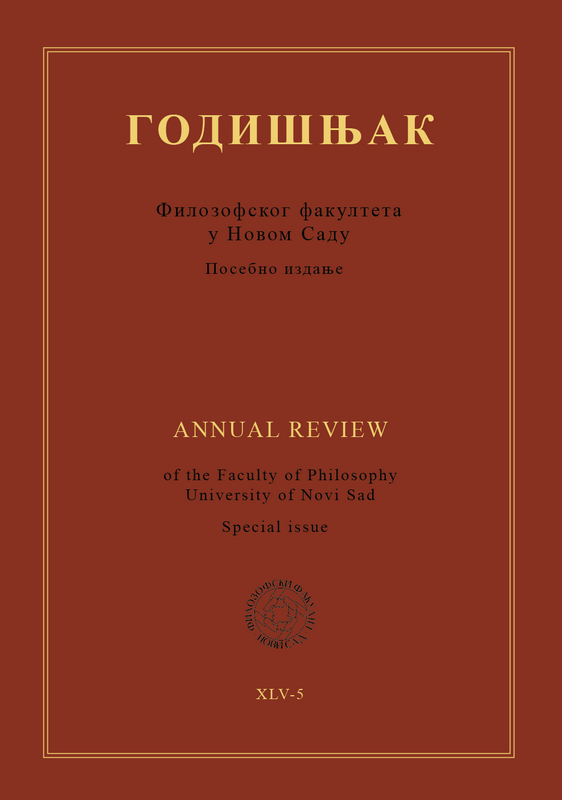UPOTREBA METADISKURSNIH MARKERA U ESEJIMA STUDENATA KOJI UČE ENGLESKI JEZIK STRUKE
Главни садржај чланка
Сажетак
U poslednje vreme, metadiskursni markeri predstavljaju čest predmet istraživanja u primenjenoj lingvistici i analizi diskursa. Svrha metadiskursnih markera jeste uspostavljanje odnosa sa čitaocem i bolje prenošenje poruke autora, što je posebno važno kada je reč o akademskom pisanju. Usled toga, metadiskursni markeri imaju važnu ulogu i u razvoju pragmatičke kompetencije onih koji uče strane jezike.
Predmet ovog istraživanja je metadiskurs u žanru studentskih eseja. Cilj istraživanja jeste da se analizira upotreba metadiskursnih markera u esejima koje su pisali studenti koji pohađaju kurseve engleskog jezika struke na univerzitetu i da ih razvrsta prema široko korišćenoj Hajlandovoj taksonomiji metadiskursnih markera. Korpus su činili eseji studenata prve godine mašinstva (N=100). Studenti su imali zadatak da napišu esej na engleskom jeziku dužine od 150 do 250 reči kao deo završnog ispita, na jednu od dve teme koje se tiču oblasti mašinstva: “Advances in Mechanical Engineering in the 21st century” i “Mechanical Engineering – Branches and Opportunities”. O ovim temama se na časovima prethodno diskutovalo, ali studenti nisu dobili uputstva o tome na koji način treba koristiti metadiskursne markere u esejima.
Rezultati pokazuju da su studenti koristili oko 52,5 markera na 1.000 reči. U okviru analize prema kategorijama Hajlandovog interpersonalnog modela metadiskursa, pokazuje se da su interakcioni markeri (607 markera ukupno, tj. 32,55 na 1.000 reči) češće korišćeni od interaktivnih markera (373 markera ukupno, tj. 20 na 1.000 reči). Najbrojniji markeri u pojedinačnim kategorijama su bile tranzitivni markeri (ukupno 281, tj. 15,07 na 1.000 reči) koje pripadaju grupi interaktivnih markera, a zatim slede markeri angažovanja (254 ukupno, tj. 13,52 na 1.000 reči) i ograde (222 ukupno, tj. 11,90 na 1.000 reči), koji pripadaju grupi interakcionih markera.
Ovakav obrazac upotrebe metadiskursnih markera u analiziranim esejima ukazuje na to da su studenti najpre želeli da uključe čitaoca u tekst, a zatim i da na odgovarajući način povežu različite ideje i da oprezno iznesu svoje stavove o datim temama. Iako se pokazalo da je većina studenata sposobna da koristi metadiskursne markere u pisanju eseja na stručnu temu na engleskom jeziku, u pojedinim slučajevima zabeležena je i pogrešna ili preterana upotreba metadiskursa. Stoga se može zaključiti da bi eksplicitno uvođenje teme upotrebe metadiskursa na časovima engleskog jezika na univerzitetu doprinelo razvijanju pragmatičke kompetencije i omogućilo studentima da se adekvatno izražavaju u pisanoj formi na engleskom jeziku pri pisanju predloga projekata, tehničke dokumentacije ili naučnih radova u njihovoj daljoj profesionalnoj karijeri.
Downloads
Детаљи чланка
Референце
Aull, L. L.Lancaster, Z. (2014). Linguistic markers of stance in early and advanced academic writing: A corpus-based comparison. Written Communication, 31(2), 151–183.
Blagojević, S. (2008). Metadiskurs u akademskom diskursu. Niš: Filozofski fakultet.
Cheng, X.Steffensen, M. S. (1996). Metadiscourse: A technique for improving student writing. Research in the Teaching of English, 30(2), 149–181.
Blagojević, S. N. (2010). Upotreba eksplicitnih jezičkih sredstava u cilju postizanja persuazivnosti u akademskom diskursu. Radovi Filozofskog Fakulteta, 12(1), 239–251.
Crismore, A.Markkanen, R. & Steffensen, M. S. (1993). Metadiscourse in persuasive writing: A study of texts written by American and Finnish university students. Written communication, 10(1), 39–71.
Crompton, P. (2012). Characterising Hedging in Undergraduate Essays by Middle Eastern Students. The Asian ESP Journal, 8(2), 55–78.
Fraser, B. (2010). Pragmatic competence: The case of hedging. In: Kaltenböck, G.–Mihatsch, W. & Schneider, S. (eds.) (2010). New approaches to hedging. Bingley: Emerald. 15–34.
Harris, Z. S. (1959). The transformational model of language structure. Anthropological Linguistics, 1(1), 27–29.
Hauranen, A. (1993). Contrastive ESP Rhetoric: Metatext in Finnish-English Economics Texts. English for Specific Purposes, 12, 3–22.
Ho, V.Li, C. (2018). The use of metadiscourse and persuasion: An analysis of first year university students’ timed argumentative essays. Journal of English for Academic Purposes, 33, 53–68.
Hyland, K. (1998). Persuasion and context: The pragmatics of academic metadiscourse. Journal of Pragmatics, 30(4), 437–455.
Hyland, K. (2000). Hedges, boosters and lexical invisibility: noticing modifiers in academic texts. Language Awareness, 9(4), 179–197.
Hyland, K. (2001). Humble servants of the discipline? Self-mention in research articles. English for Specific Purposes, 20(3), 207–226.
Hyland, K. (2004). Disciplinary interactions: Metadiscourse in L2 postgraduate writing. Journal of Second Language Writing, 13, 133–151.
Hyland, K. (2005). Metadiscourse: Exploring Interaction in Writing. London, New York: Continuum.
Hyland, K. (2006). English for academic purposes: An advanced resource book. London: Routledge.
Hyland, K. (2017). Metadiscourse: What is it and where is it going? Journal of Pragmatics, 113, 16–29.http://doi.org/10.1016/j.pragma.2017.03.007
Hyland, K.–Tse, P. (2004). Metadiscourse in academic writing: A Reappraisal. Applied Linguistics, 25(2), 156–177.
Intaraprawat, P.Steffensen, M. (1995). The use of metadiscourse in good and poor ESL essays. Journal of Second Language Writing, 4(3), 253–272.
Kobayashi, Y. (2016). Investigating Metadiscourse Markers in Asian Englishes: A Corpus-Based Approach. Language in Focus, 2(1), 19–35.
Lee, J. J.Deakin, L. (2016). Interactions in L1 and L2 undergraduate student writing: Interactional metadiscourse in successful and less-successful argumentative essays. Journal of Second Language Writing, 33, 21–34.
Lee, J.Subtirelu, N. (2015). Metadiscourse in the classroom: A comparative analysis of EAP lessons and university lectures. English for Specific Purposes, 37(1), 52–62.
Li, T.Wharton, S. (2012). Metadiscourse repertoire of L1 Mandarin undergraduates writing in English: A cross-contextual, cross-disciplinary study. Journal of English for Academic Purposes, 11(4), 345–356.
Meyer, B. (1975). The Organization of Prose and its Effects on Memory. Amsterdam: North-Holland.
Rossiter, C. M. (1974). Instruction in metacommunication. Central States Speech Journal, 25(1), 36–42.
Schiffrin, D. (1980). Meta-talk: Organisational and evaluative brackets in discourse. Sociological Inquiry: Language and Social Interaction, 50, 199–236.
Steffensen, M. S.Cheng, X. (1996). Metadiscourse and Text Pragmatics: How Students Write After Learning about Metadiscourse. Pragmatics and Language Learning, 7, 1–18.
Vande Kopple, W. (1985). Some exploratory discourse on metadiscourse. College Composition and Communication, 36, 82–93.
Vande Kopple, W. (2002). Metadiscourse, discourse, and issues in composition and rhetoric. In: Barton, E.–Stygall, G. (eds.) (2002). Discourse Studies in Composition. Cresskill, NJ: Hampton Press. 91–113.
Vande Kopple, W. (2012). The importance of studying metadiscourse. Applied Research in English, 1(2), 37–44.




